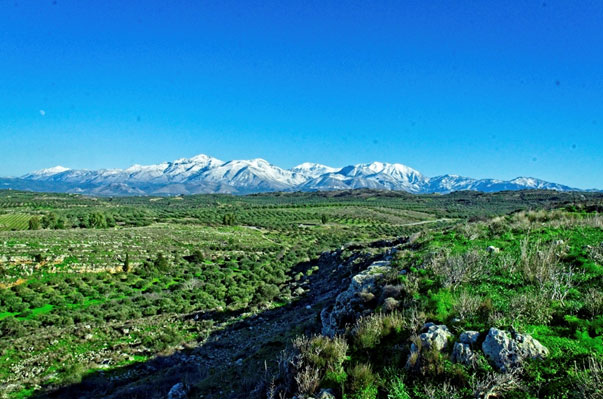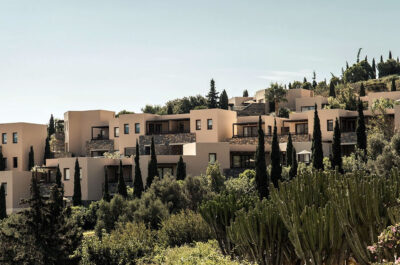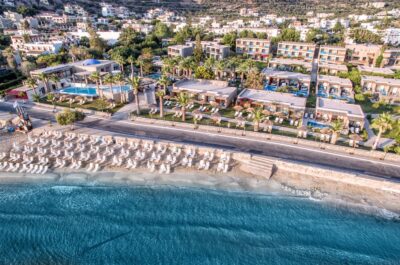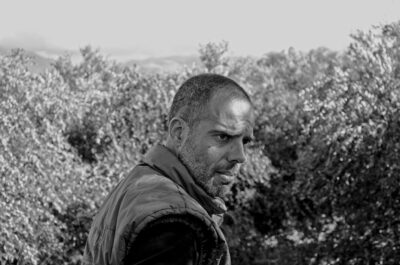
Standing beneath the palace looking eastward toward Lassithi and the mountains.
For those who have never toured Crete by car, the experience is a non-stop spectacle of discovery, and this is especially true if you leave your phone-navi at home.
The unbelievable adventure that is our life on Crete carries my family and me to some of Europe’s most amazing landscapes. However, what is even more amazing than indescribable geology and nature is the culture, tradition, and unmistakable soul of this place. The following is a story as old as the dawn of human civilization and as new as a sweet, sincere Cretan villager’s smile.
“We, who are dying, are doing better, than they, who will live. For Crete doesn't need householders, she needs madmen like us. These madmen make Crete immortal.”
Nikos Kazantzakis – Freedom and Death (1956).
Immortality, that’s the word I’ve been looking for to describe the true treasures of Crete island. Once again it’s taken a family adventure to reacquaint us with the real soul of Greece’s biggest island. Since moving here, me, my wife Mihaela (Mig), and our little boy Paul have made many friends and explored places from Chania Prefecture to Lassithi and Ierapetra. But a trip to find a lost Minoan city outside famous Arkalochori is a story every traveler should read or hear. My family’s adventure to Galatas some days ago took us to an ancient Bronze Age palace that went unnoticed for millennia. It was a journey to rediscover Filoxenia, that unique Greek caring for strangers, all over again.
For those who have never toured Crete by car, the experience is a non-stop spectacle of discovery, and this is especially true if you leave your phone-navi at home. A couple of weeks back, we found out how fate plays a vital role on the ancient island of the Minoans. Three attempts to locate and explore the Galatas Palace archeological site delivered us once again to the unmistakable soul of this marvelous island. If you come here, I urge you to give in to and let fate takes its course, for Crete will never let you down.
Day One: The Sign
On our first “try” at finding this secluded lost city, we ventured off the main highway in between Crete’s capital in Heraklion and the amazing village of Arkalochori halfway into the island’s interior. To say we were “lost” driving down the narrow country road might be a stretch, though, since living on an island makes it pretty tough to be truly without bearings. Nevertheless, after exploring the hillsides overhanging the hamlet of Choumerio (Χουμέριο), all that we managed was meeting a very friendly local farmer, a big flock of sheep in a pasture overlooking the town, and a wonderful gas station owner.
Don’t be dismayed reading this, for this part of Crete is an unsung paradise of green pastures, endless olive groves, springs, streams, and an indescribable variety of flora. At the end of our first trip, darkness closed in quickly, leaving us a bit daunted. That was, until little Paul gestured out the car window in excitement, exclaiming, “Look, God is showing us the way.” Sure enough, there painting the butte on the east side of the valley was the biggest sunbeam I’ve ever seen. Arriving back home we all three promised to “Google” the palace and to return armed with better dead-reckoning. And this we did, slapping our heads over just how close we had been all along.
Day Two: The Cretan Way
The week passed slowly until Paul and I were awakened early the next Saturday morning by Mig. Rethinking her rousing us that day, I recall how this latest Crete mystery had hold of us all since our collective enthusiasm was pointed. So, whatever was propelling us, we all leaped up and jumped into our little Ford Ka without even a thought for breakfast. Quicker than before, we reached the lush valley beneath where the “sign” had pointed out the lost city for us. On up to the outskirts of Arkalochori we rode, then turned left onto the road that leads across a narrow ridge that divides the central part of Heraklion Prefecture. Soon we passed the little hamlet of Archontiko Αρχοντικό with its interesting church that forces the road to bend. Certain we were on the path, we continued a few hundred meters until we found the dirt road leading up a precipice, the same trek we’d seen via Google Earth. Turning off to try and make the ascent, we found the road untraversable for our little passenger car. Then fate stepped in once more when Mig reminded me, “I am starving, and I know Paul is too.”
Discretion being the better part of valor, I jumped back onto the asphalt road and headed for Galatas proper, which is now an almost abandoned hamlet two-thirds of the way in between Arkalochori and Voni. Knowing how my wife’s tolerance is often tied to stomach emptiness or boredom, I guess the reader knows I was praying all along for an open taverna up ahead. Luckily, or by the fates again, we came to a little wooden shingle that read Το μουρέλο του Λαδωμένου, where my amateur archeologist dreams were kept alive. All was not lost, we thought, but if we’d only known.
Το μουρέλο του Λαδωμένου, or “The Little Olive Tree of Ladomenos,” is a tiny little bit of joy in the almost deserted village of Galatas. Situated at an altitude of 385 meters, the ancient town is home to less than 100 people these days. Once a Venetian village and later occupied by the Ottomans, the town is barely visible if you search for it on the internet, that is if not for Galatiani Kefala (the lost city) which sits overlooking it. Obscure as this pretty little place is though, the village harbors a spirit pure and simple as time itself. We began to sense this in the instant the burly farmer inside the tavern gestured us inside as he pointed his glass of raki, “Ella, ella,” the big bearded Cretan boasted. So, we pulled out the wooden chairs right by the warmth of the blazing hearth of the small dining room.
We entered The Little Olive Tree not knowing what to expect. At first, I was skeptical of outcomes when a man who was clearly a farmer gestured for us to come in by pointing a full glass of raki in my direction. Knowing how on Crete everything gets better after four, five, or six shots of the dry alcohol (tsikoudia), I wasn’t sure our weary crew was ready for an all-night celebration. And then Popi appeared from the kitchen in the back wearing a beautiful smile big as day. The daughter of Markos and wife of the amazing chef Grigoris, Popi Ladomenou multi-tasks as a university professor in Heraklion, as tavern manager at Galatas, and as mom and husband at the same time. Her brilliant husband, whose mouthwatering Cretan cuisine is at the top of all our lists, also wears many hats. But unlike in some cultures, on Crete long days and weeks carving a living is just normal – everyone is a 24/7 worker bee driven to provide the best they can. While I would love to share more about our afternoon at the taverna, and about the unbelievable food, the real value of this island, this valley, and this Little Olive Tree discovery is not gastronomy. Now, hopefully, I can share with you the soul of this incredible island.
About halfway through several courses of Cretan cheeses, smoked and grilled meats, a wood oven baked ham dish to die for, and homemade wine Popi came back and leaned over our table with a suggestion after learning the road had washed out to the ruins. “My father Markos says he’d be happy to take you guys up to the ruins in his four-wheel drive if you want,” she said shyly. Astonished at the unsolicited thoughtfulness, we agreed, as if anyone on Earth could say no to such kindness. We tanked Popi and Markos Ladomenos, and since it was very late by this time, we agreed to connect via phone and Facebook to schedule a more perfect time. With evening wearing on, we stayed another hour enjoying the company of new friends, heading home after a cementing these friendships with several rounds of toasts, stories of the village, legends of Minoan treasure hunters, and the genuine love most Cretans shower visitors with. On the trip home, Mig, Paul, and I vowed to finally make it to the lost city with the help of these wonderful folks.
Day Three: The Treasure of Lost Galatas
The story of our return to Galatas is another chapter in what it means to be Cretan. The day after arriving home, I got a call from Grigoris telling me he’d planned an excursion to introduce us not only to the Minoan Palace but to two nearby monasteries, the older part of the village of Galatas, followed by a private cookout at The Little Olive Tree. Superlatives and exclamations for describing how I felt hearing Grigoris’ suggestions escape me here. I apologize. You see, on Crete, amazing interactions and the fates always seem to come into place somehow. Again, I could not refuse such generosity. So, we agreed on the following Wednesday, which I later found out is the only day this family has a moment to spare.
As prescribed, we made the trip to Galatas on Wednesday, finding Grigoris and Markos ready by the elder’s Toyota 4×4 pickup. Greetings, and then we climbed aboard for an adventure none of us will ever forget. With Grigoris crammed in the back with Paul and Mig, Markos puttered down the narrow road to the turnoff to the palace. The five of us, interestingly, rode the two kilometers in almost total silence, which made me feel the “grip” of this amazing place even more. Now that I think back, those ruins on that hillside possess the spirit of something far more powerful than ceramic relics or votive offerings to long lost gods. We broke out of our collective daze about the time Markos pulled the emergency brake of the truck.
There it was, laid out like all those majestic ruins you’ve seen on National Geographic or the History Channel, not just a palace, but what was clearly a major city once. Excited, we all clamored out to feast our eyes on an incomparable viewpoint of Crete island. Even the images do not show how beautiful this place is. Mason’s marks on the stone walls just over the chain link fence, giant foundation pieces so perfect a knife will not go between them, and room after room surrounding a central court that must have been magnificent in its day. In fact, the whole palace is a thing of immense beauty, even in its ruined state. Walking around the site, seeing Paul sitting on the edge of eternity and looking out over unbelievable Crete – well, I have no words. You must go there, that is all I can say.
I had to literally drag little Paul from the edge of the cliff overlooking the valleys. He kept saying, “Dad, let’s stay. There’s something very special here.” Later on, we all knew what this sweet and innocent little boy knew. Markos and Grigoris took us down the mountain to visit Agios Ioannis Church, where he watered his village’s animals from a miraculous spring, as a child. Next, we did the tour of the old part of Markos’ village, saw the house where he was born, and I almost wept at how such an unbelievable place had fallen into complete ruin. Down the mountain we rode a goat path with a 200-foot sheer drop so that our tour guide could show us sea fossils from millions of years ago, sticking out from the side of the hill like souvenirs. And sure enough, Markos insisted I pluck one from the mud to carry back to Heraklion. Onward they took us to the most famous monastery of Crete, Agia Marina, a sacred place that welcomes hundreds of thousands each July 17th. There, we met Sister Marina, a nun who has lived at and cared for the monastery since her childhood. The last of her order, the 90-something lady, blessed us, which is another story, for another time.
Back up the mountain to The Little Olive Tree of Ladomenos, we found Markos’ wife, Giota lighting the hearth, so that we could all warm our chilled bones. Then, Grigoris summoned Mig and I to the kitchen. “What can I prepare for you,” he said as he smile at us brightly. Stunned, almost ashamed, we stood there speechless. “No really, tell me what you are hungry for,” he said sweetly. Acquiescing, we reminded the chef of our adoration for his wild Horta greens in virgin olive oil, the Apaki (salted, smoked, lean pork) the taverna excels at, and we left the rest to his discretion. The feast he prepared, the hang plucked salad leaves and tendrils, and the succulent wood oven pork his taverna is famous for, filled up our souls – literally. I am not stretching the truth one millimeter, the chef at this taverna has the soul of a master chef, and as wise as the saint for whom he is named. The moral of this Cretan travel log is that The Little Olive Tree of Ladomenos is the chapel that holds the light those ancient Minoans shined over central Crete thousands of years ago. Ah, but the signal fires of Galatas and the palaces, that too is another story.
The lost treasure of ancient Galatas is not lost at all. The spirit of these Cretan people lives on, forever, unchanged for untold centuries before – and no doubt, for centuries to come. The farther we travel afield here, the more in touch with this indescribable spirit we become. My friend, Minas Liapakis tells me, “You love the island like we do. You are Cretan,” he tells me. I suppose this is true. Maybe I was here 5,000 years ago when the first Minoan leader broke ground on a hidden hill that overlooked a garden like Eden. You can still see this “Eden” in some of my photographs like you can see the ancient signal fires reflected in Markos Ladomenos’s eyes when he stares into the fire at The Little Olive Tree of Ladomenos.
Phil is a prolific technology, travel, and news journalist and editor. An engineer by trade, he is a partner in one of Europe’s leading PR and digital marketing firms, Pamil Visions PR.
He’s also a Huffington Post contributor on many topics, a travel and tech writer for The Epoch Times in print and online, and for several magazines including Luxurious.
Phil also contributes regularly to TravelDailyNews, The official Visit Greece Blog, and is an analyst for Russia Today and other media.
His firm has done all the content for Time Magazine’s top travel site Stay.com, as well as other online travel portals such as Vinivi out of France. He’s also a very influential evangelist of social media and new digital business, with a network of some of the most notable business people therein.





























































































































































































































